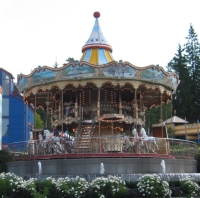Which way do carousels move?
As I walked towards UNESCO for the second day of the opening event of IYL2015, I discovered two carousels on different sides of the Seine, moving in opposite directions – counter-clockwise on the right bank and clockwise on the left bank, just northwest of the Eiffel tower.
It reminded me of spectacular quantum physics experiment where a beryllium ion was prepared in a superposition state with itself, with “50 percent probability of being in a “spin-up” state in its initial position and an equal probability of being in a “spin-down” state in a position as much as 80 nanometers away, a vast distance indeed for the atomic realm. In effect, the atom was in two different places, as well as two different spin states, at the same time” (Scientific American, 1996). This beryllium ion is such a spooky illustration of the quantum world, “an atomic analog of a cat both living and dead”, i.e. “Schrödinger’s cat”, and was part of the motivation for the Nobel prize in physics 2012, shared by Dave Wineland and Serge Haroche. Continue reading

